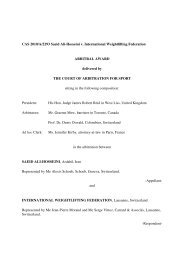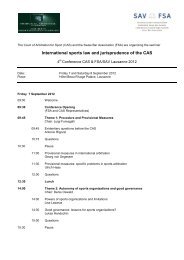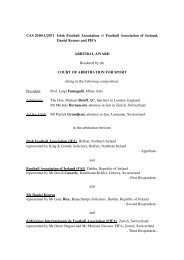(CAS) Bulletin - Tribunal Arbitral du Sport / TAS
(CAS) Bulletin - Tribunal Arbitral du Sport / TAS
(CAS) Bulletin - Tribunal Arbitral du Sport / TAS
You also want an ePaper? Increase the reach of your titles
YUMPU automatically turns print PDFs into web optimized ePapers that Google loves.
WADA that the calculations regarding this person<br />
show a 25% greater concentration of clenbuterol than<br />
in Mr. Contador’s sample, is misguided according<br />
to Prof. Martín-Jiménez, since in pharmacokinetics<br />
it is well known that one needs to study a large<br />
population of indivi<strong>du</strong>als in order to quantitatively<br />
describe relationships between demographic or<br />
clinical variables and drug exposure parameters.<br />
According to the Athlete, the volumes relied upon<br />
by WADA are fl awed. One cannot de<strong>du</strong>ct from<br />
the data based on a few doping tests the total daily<br />
urine volume, since the volume gathered <strong>du</strong>ring<br />
doping control tests is limited by the size of the urine<br />
collection vessel. In addition the Athlete points out<br />
that, for reasons of hygiene, he never fi lls the whole<br />
vessel to the brim.<br />
The Athlete therefore con<strong>du</strong>cted a test of his own, to<br />
use as evidence in this proceedings, and on such basis<br />
fi led a report concluding that he pro<strong>du</strong>ced an average<br />
daily volume of urine of 2.115 L.<br />
The Panel accepts the allegation that an athlete for<br />
reasons of hygiene would usually not fi ll the collection<br />
vessel to the brim. However, based on all the evidence<br />
ad<strong>du</strong>ced and in particular the expert testimony at<br />
the hearing, including Dr Ashenden’s indication<br />
that professional athletes usually have a lower urine<br />
pro<strong>du</strong>ction than normal persons <strong>du</strong>e to being partially<br />
dehydrated, the Panel is reluctant to accept that the<br />
Athlete has an average urine pro<strong>du</strong>ction of 2.115 L<br />
per day. In reaching this conclusion the Panel took<br />
into account that, on the one hand, the sample was<br />
taken <strong>du</strong>ring the Tour de France and, on the other,<br />
that it was not collected <strong>du</strong>ring the competition but<br />
on a rest day. In this respect the Panel rejects the<br />
assertion of Mr Contador in his submissions stating<br />
that, since it was a rest day the test should not have<br />
been considered an in-competition test. In doing so,<br />
the Panel refers to the defi nitions contained in the<br />
UCI ADR, according to which ‘In-Competition refers to<br />
the period that starts one day before or, in the case of a major<br />
tour three days before the day of the start of an Event and<br />
fi nishing at midnight of the day on which the Event fi nishes’.<br />
In addition, the Panel took into consideration that<br />
the Athlete’s test was not carried out in a controlled<br />
environment, corresponding to the typical conditions<br />
required of a scientifi c experiment.<br />
However, one must also note that the data coming<br />
from WADA concerning the Athlete did not come<br />
from a scientifi cally controlled environment either.<br />
Hence the data before this Panel must be evaluated<br />
and used with caution. Summing up, therefore, the<br />
Panel fi nds that an average urine pro<strong>du</strong>ction of 2.115<br />
L is rather at the high end of the possible range when<br />
assessing the blood transfusion as a whole.<br />
5.3.3.4 Fitting to the data<br />
The experts also debated on the topic of “data fi tting”<br />
<strong>du</strong>ring the hearing.<br />
According to WADA, the oral model (for the intake<br />
of Clenbuterol) used by Prof. Martín-Jiménez is<br />
incorrect.<br />
However, Prof. Martín-Jiménez is of the opinion<br />
that the model used in this particular case to obtain<br />
predictions is less important than the fi tting of the<br />
data at hand. Furthermore, Prof. Martín-Jiménez is<br />
of the opinion that the intravenous data upon which<br />
Dr Rabin relied is not well fi tted, which skewed the<br />
results obtained and reported. By way of illustration,<br />
Prof. Martín-Jiménez states that he was able to better<br />
fi t the intravenous data to his old oral model than Dr<br />
Rabin did with his intravenous model. In practical<br />
terms, this allegedly would mean that the results<br />
obtained and reported by Dr Rabin in relation to<br />
urinary concentrations of clenbuterol were biased in<br />
favour of WADA’s position. In order to obtain more<br />
accurate predictions based on the intravenous data,<br />
Prof. Martín-Jiménez applied the intravenous data to<br />
his own intravenous model.<br />
The panel took note of the differences of opinions<br />
between the two experts in relation to this issue of<br />
fi tting.<br />
However, with respect to the overall assessment and<br />
conclusion in respect of the blood transfusion theory,<br />
the panel considers that the impact on the fi ndings of<br />
the experts’ deriving from their different approaches<br />
to the fi tting of the data is insignifi cant enough to<br />
not require a determination as to which method is<br />
better suited.<br />
5.4 The Panel’s conclusions regarding the Blood<br />
Transfusion Theory<br />
As a preliminary matter, the Panel notes that the<br />
primary object of this appeal is the fi nding of a<br />
Prohibited Substance (clenbuterol) in the Athlete’s<br />
Sample.<br />
Only on a secondary basis is the Panel invited to<br />
consider the scenario of a blood transfusion. Indeed,<br />
neither the UCI nor WADA initiated nor requested<br />
to initiate disciplinary proceedings against Mr<br />
Contador in respect of an alleged blood transfusion;<br />
the theory of the blood transfusion having only been<br />
raised, together with the food supplement’s scenario,<br />
by the Appellants as an explanation for the adverse<br />
Jurisprudence majeure / Leading cases<br />
-<br />
136





